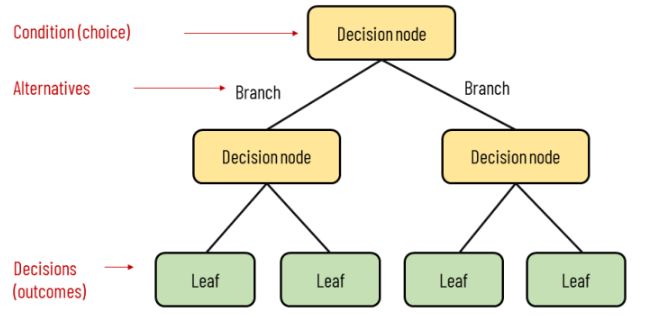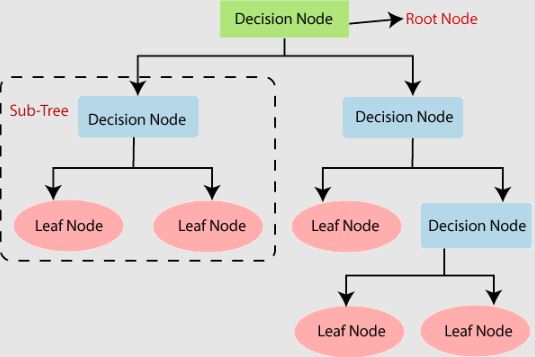
Difference between Openshift and Kubernetes : A Complete Guide
Last updated on 30th Jan 2023, Artciles, Blog
- In this article you will learn:
- 1.What is a Decision Tree?
- 2.Types of Decisions.
- 3.Applications of Decision Trees.
- 4.Advantages of Decision Trees.
- 5.Disadvantages of Decision Trees.
- 6.Conclusion.
What is a Decision Tree?
A decision tree is support tool with the tree-like structure that are models probable outcomes, cost of resources, utilities, and possible consequences. Decision trees are provide a way to present a algorithms with conditional control statements. They include a branches that represent a decision-making steps that can lead to be favorable result.
Types of Decisions:
There are two main types of a decision trees that are based on a target variable, i.e., categorical variable decision trees and a continuous variable decision trees:
1. Categorical variable decision tree:
A categorical variable decision tree are includes a categorical target variables that are divided into the categories. For example, the categories can be a yes or no. The categories mean that each stage of a decision process falls into one category, and there are be no in-betweens.
2. Continuous variable decision tree:
A continuous variable decision tree is the decision tree with continuous target variable. For example, an income of individual whose income is unknown can be predicted based on the available information like their occupation, age, and other continuous variables.

Applications of Decision Trees:
1. Assessing prospective growth opportunities:
One of t applications of decision trees involves an evaluating prospective growth opportunities for a businesses based on historical data. Historical data on a sales can be used in a decision trees that may lead to be making radical changes in strategy of a business to help aid expansion and growth.
2. Using a demographic data to find a prospective clients:
Another application of decision trees is in use of demographic data to found a prospective clients. They can help to streamline a marketing budget and make informed decisions on a target market that are business is focused on. In absence of decision trees, a business may spend its marketing market without specific demographic in a mind, which will affect by overall revenues.
3. Serving as support tool in a several fields:
Lenders also use a decision trees to predict probability of the customer defaulting on a loan by applying predictive model generation using client’s past data. The use of decision tree support a tool can help lenders an evaluate a customer’s creditworthiness to a prevent losses.Decision trees can also be used in the operations research in planning logistics and also strategic management. They can help in for determining appropriate strategies that will help to company achieve its intended goals. The Other fields where decision trees can be applied by include engineering, education, law, business, healthcare, and also finance.
Advantages of Decision Trees:
1. Easy to read and interpret:
One of advantages of a decision trees is that their outputs are simple to read and interpret without a requiring statistical knowledge. For example, when using a decision trees to present demographic information on a customers, the marketing department staff can be read and interpret a graphical representation of a data without requiring a statistical knowledge.The data can also be generate an important insights on probabilities, costs, and alternatives to different strategies formulated by a marketing department.

2. Easy to prepare:
Compared to the other decision techniques, decision trees take a less effort for data preparation. However, users need to have a ready information to create a new variables with power to predict a target variable. They can also create the classifications of data without having to compute complex calculations. For a complex situations, users can be combine decision trees with the other methods.
3. Less data cleaning required:
Another advantage of a decision trees is that there is a less data cleaning needed once a variables have been created. Cases of a missing values and outliers have a less significance on a decision tree’s data.
Disadvantages of Decision Trees:
1. Unstable nature:
One of limitations of a decision trees is that they are largely unstable compared to the other decision predictors. A small change in a data can result in the major change in a structure of a decision tree, which can convey a various result from what users will get in the normal event. The resulting change in a outcome can be managed by a machine learning algorithms, such as a boosting and bagging.
2. Ineffective in forecasting the result of a continuous variable:
Furthermore decision trees are less effective at making predictions when the primary purpose is to anticipate the outcome of a continuous variable. This is due to the fact that decision trees lose information when grouping variables into several groups.
Conclusion:
Decision trees are one of the best forms of learning algorithms based on various learning methods. They boost predictive models with accuracy, simplicity in interpretation, and stability. The tools are also be effective in fitting non-linear relationships since they can solved a data-fitting challenges, like regression and classifications.